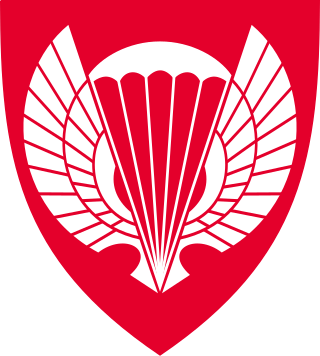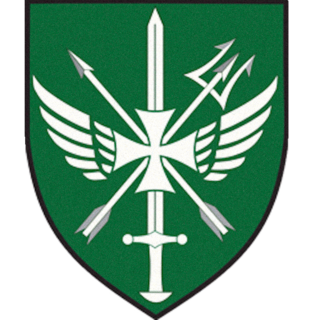
Conscription is the state-mandated enlistment of people in a national service, mainly a military service. Conscription dates back to antiquity and it continues in some countries to the present day under various names. The modern system of near-universal national conscription for young men dates to the French Revolution in the 1790s, where it became the basis of a very large and powerful military. Most European nations later copied the system in peacetime, so that men at a certain age would serve 1–8 years on active duty and then transfer to the reserve force.
Danish Defence is the unified armed forces of the Kingdom of Denmark charged with the defence of Denmark and its self-governing territories Greenland and the Faroe Islands. The Defence also promote Denmark's wider interests, support international peacekeeping efforts and provide humanitarian aid.

The Latvian National Armed Forces, or NBS, are the armed forces of Latvia. Latvia's defense concept is based on a mobile professional rapid response force and reserve segment that can be called upon relatively fast for mobilization should the need arise. The National Armed Forces consists of Land Forces, Naval Forces, Air Force and National Guard. Its main tasks are to protect the territory of the State; participate in international military operations; and to prevent threats to national security.

The Jaeger Corps also known as the Huntsmen Corps is an elite special operations force of the Danish Defence part of Special Operations Command, formerly of the Royal Danish Army, based at Aalborg Air Base.

The Norwegian Army is the land warfare service branch of the Norwegian Armed Forces. The Army is the oldest of the Norwegian service branches, established as a modern military organization under the command of the King of Norway in 1628. The Army participated in various continental wars during the 17th, 18th, and 19th centuries as well, both in Norway and abroad, especially in World War II (1939–1945). It constitutes part of the Norwegian military contribution as a charter member of the North Atlantic Treaty Organization (NATO) since 1949.

The Norwegian Military Academy, in Oslo, educates officers of the Norwegian Army and serves as the King's Royal Guard. The academy was established in 1750, and is the oldest institution for higher education in Norway.

The Norwegian Armed Forces is the military organization responsible for the defence of Norway. It consists of five branches, the Norwegian Army, the Royal Norwegian Navy, which includes the Coast Guard, the Royal Norwegian Air Force, the Home Guard, and Norwegian Cyber Defence Force as well as several joint departments.

Marinejegerkommandoen (MJK) is the maritime/naval special warfare unit of the Norwegian Armed Forces and was established in 1953.

Hærens Jegerkommando (HJK) was a special forces unit of the Norwegian military. It was the armed forces competence centre for commando, airborne and counter terrorist duty in the Norwegian Army. Its headquarters were located 30 kilometres north of Elverum in the southeast of Norway, at Rena leir military base. In 2006, the unit was merged with Forsvarets Spesialkommando/Special Operations Commando.

Forsvarets Spesialkommando (FSK) is a special operations forces unit of the Norwegian Special Operation Forces. The unit was established in 1982 due to the increased risk of terrorist activity against Norwegian interests, including the oil platforms in the North Sea.

Minedykkerkommandoen (MDK) or Norwegian Naval EOD Command is a clearance diver group. MDK is subordinate to the Royal Norwegian Navy. MDK is located at Haakonsvern Naval Base in Bergen and Ramsund Naval Base, in vicinity of Harstad.
Northern Viking is an annual NATO exercise held in Iceland. The exercises were held biennially until 2006 when the frequency was increased. The purpose of the exercise is to test the capabilities of Iceland and its NATO allies, as well as increase the readiness of the forces involved and their inter-operability.

The Structure of the Norwegian Army has seen considerable change over the years. In 2009 the Army introduced the new command and control organization. As of June 2021 the army is organized as follows:

European countries have had varying policies that confine women and military service or the extent of their participation in the national armed services of their respective countries, especially combatant roles in armed conflicts or hostile environments. While most of the countries have always allowed women to participate in military activities involving no direct aggression with the enemy, most began seeing the value of servicewomen in the armed services during the First World War when they began losing unprecedented numbers of servicemen. In the modern era, many of the European countries allow women to voluntarily pursue a career path or profession in the national armed services of their country as well as permit conscription equality, with minimal or no restrictions at all.

Kystjegerkommandoen is a unit in the Royal Norwegian Navy. KJK is a marine commando unit trained to operate in littoral combat theatres, filling the role of marines and coastal artillery.

The Georgian Special Operations Forces (GSOF) are the special operations forces component of the Defense Forces of Georgia. They have been established to conduct special operations, special-and long range reconnaissance, military counter intelligence, counter terrorism, counter insurgency, amphibious and asymmetric warfare in and outside Georgia.
The Swedish Special Operations Task Group, is a special forces unit within the Swedish Armed Forces which has been active since 2011. The unit is headquartered at Karlsborg Fortress in Karlsborg, Västra Götaland County.

Trident Juncture 18, abbreviated TRJE18, was a NATO-led military exercise held in Norway in October and November 2018 with an Article 5 collective defence scenario. The exercise was the largest of its kind in Norway since the 1980s. An expected 50,000 participants from 31 nations partook, including 10,000 vehicles, 250 aircraft and 65 vessels. The exercise was mainly held in the central and eastern parts of Norway, in addition to air and sea areas in Norway, Sweden and Finland. The stated goal of Trident Juncture was to train the NATO Response Force and to test the alliance's defence capability. According to the Norwegian Armed Forces, the exercise tested the country's ability to receive and handle allied support.

Eirik Johan Kristoffersen is a Norwegian Army General who serves as the head of the Norwegian Armed Forces. He is a former Chief of the Norwegian Army and Norwegian Home Guard, and Chief of the Armed Forces' Special Command (FSK).















